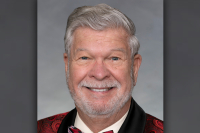Choice of victims makes this a disturbing read
Stephen Hunter’s I, Sniper (ISBN 978-1-4165-6515-4, $26) brings to readers once again that intrepid sniper, now old and aching from his lifetime of combat, Bob Lee Swagger. As in previous novels in this series, the government entangles itself into the retired Marine’s life, hauling him out of retirement to help track down a killer of left-wing radical leftovers from the 1960s. Swagger soon finds himself both hunter and prey as he sets about solving a string of assassinations.
The story begins when four radicals, now wealthy members of America’s elite political class, are shot to death by a skilled sniper. Retired Marine war hero Carl Hitchcock, who was a sniper himself in Vietnam, is a suspect in the shootings and, when found dead in a motel room, an apparent suicide, is blamed by most investigators for the killings. Two FBI agents, the rising star Nick Memphis and the competent Jean Chandler, find the case too neatly packaged and begin to suspect that Hitchcock was either set up or had help from accomplices. Baffled by certain aspects of the case, particularly the assassin’s expertise and some clues that he may personally have known his victims, the pair of agents calls on Swagger for help.
Like many heroes of this literary genre, Swagger is a loner. He fought in Vietnam as a sniper, and since then has tried to live out his life on his Western ranch with his wife and daughter. In Swagger, Hunter has created an American man who has his prototype in Natty Bumpo and who is the reincarnation of Daniel Boone and John Wayne, a man’s man doing, as the adage goes, “what a man’s got to do.” Never mind the aching of old wounds, the pains brought on by turning 60, the temptation to give up the chase and return to his quiet life with his wife: Swagger has a new mission to fulfill and can’t rest until the bad guys are brought to justice or to the grave.
Some parts of this thriller will either amuse or offend readers. First, reading I, Sniper is akin to a tour of a gun show. Hunter is a capable guide to this printed armory. His list of mentors at the back of the book includes such luminaries as Dr. John Matthews, founder of Sure Fire LLC, “for information on modern suppressors,” and Lew Merletti, “former Director of the U.S. Secret Service, for fast, accurate feedback on equipment and tactics.” Readers who love talking guns will no doubt enjoy the pages of this book rhapsodizing on the uses of a Mossberg shotgun or a Remington 700 bolt action. Most of the rest of us will simply brush aside these gunpowder treatises and bolt onto the next action scene.
Hunter’s choice of characters might also raise a few eyebrows or a few laughs, depending on the reader’s view of contemporary society. Joan Flanders, the first victim of the sniper, is clearly derived as a character from Jane Fonda. Hunter tells us that “her second husband had been an antiwar leader in the raging if far-off sixties, and her picture, aboard the gunner’s chair on a North Vietnamese anti-aircraft battery, had made her instantly beloved and loathed by equal portions of her generation.” Jack Strong and Mitzi Reilly, found shot dead in Volvo on a Chicago back street, resemble radicals like William Ayers and Bernadette Dorn, making their living as professors and leading a posh life in Chicago’s Hyde Park. Mitch Greene, an Abbie Hoffman-like prankster who’d written a “lefto-tilt version of American history,” dies from the sniper’s bullet in Cleveland while signing books during a speaking engagement.
Tom Constable, former husband to Joan Flanders, owner of a major network, former owner of a major league sports team, and now a man who is primarily interested in Old West fast-draw shooting contests, is clearly modeled after Ted Turner. After Hitchcock’s suicide, Constable pushes the FBI to close his former wife’s case, claiming that he wants to avoid both the besmirching of her name and the uproar of publicity the murders have aroused. Hunter’s portrait of Constable/Turner as the fastest gun in the West, Texas Red, will amuse most readers:
Related Items
“Tom never did things halfway. He was a creature of obsessions, and when he discovered a new one, whether it was sailing, radical politics, billions making, movie star courting, book writing, network starting, old movie colorizing, whatever, he hammered it with the full force of will and intelligence until it became his, he beat it into the shape he desired…He loved being Texas Red. Wild as a pony, fast, loose, beautiful, proud, dangerous, all the things that Tom himself had once aspired to be and that, even though he was a buccaneer of business, he felt he’d never really let out.”
Despite the fact that thinly-disguised public figures have become objects of assassination — think of the novel Checkpoint and the abominable movie “The Death of a President,” both focusing on murdering off George Bush — there is something about using living people as the targets for assassination that will leave many readers squeamish. Granted that Jane Fonda and Ted Turner are not among the most beloved of American icons, especially among the probable readers of Stephen Hunter’s novels, it is still unsettling to see them portrayed as they are in I, Sniper. The murder of Flanders/Fonda along with the other radicals, and the portrayal of Constable/Turner, should leave a bitter taste in the mouths of discriminating readers.
Stephen Hunter has written some fine suspense novels in his Robert Lee Swagger series. Despite its fast-paced action, however, I, Sniper is unworthy of any place among its predecessors, if for no other reason than the ill-spirited portrayal of some of its protagonists.
I, Sniper by Stephen Hunter. Simon & Schuster, 2009. 418 pages









